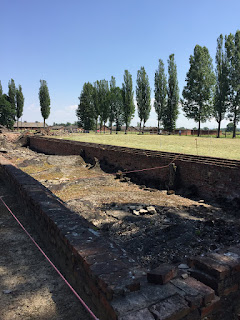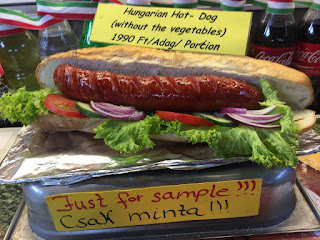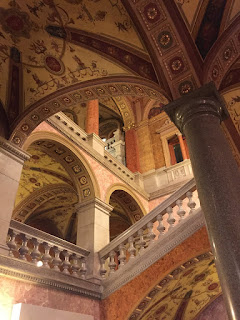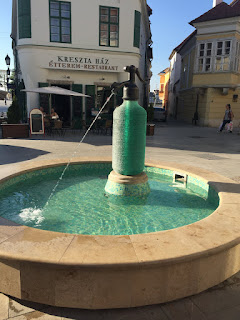Krakow - Part I
Let me just say, I have NEVER been in a place that was so Catholic. For those who know me, that is saying a lot. There is a church on every block. There are many priests and nuns walking the streets in full habits. Lots of people wear religious jewelry. Pretty much everyone you talk to is Catholic. The Church is a dominant cultural entity. Local boy Pope John Paul II (Pope from 1978-2005), newly beatified, is a hero with a museum, statues and iconography because of how he stood up to the Communists and gave hope to the opposition. However, his conservatism and lack of response on priestly pedophilia did not endear him to all.
I understand why Lou's mother first tried to enroll him in a Catholic school when they first came to the U.S. The principal who was a nun explained that they taught religion in this school. His mother said, yes, she understood, didn't every school? Well, no, Mrs. Silberman, send little Louie to public school - no religious instruction there. I do not think it has changed much in the last 60 years in many parts of Poland.
Our first overnight train - in separate, private compartments as in Lou in one and me in another (!) brought us to Krakow early in the morning. Our little pension was a 10 minute walk from the train station and we have become quite adept at transitioning from place to place without much fuss.
We are staying at a cute and very welcoming pension in Old Town right off yet another magnificent square framed by two churches, one big and one little, the Cloth Hall where the cloth sellers had their stalls in the Middle Ages and the Town Tower. Cafes and fountains surround the square along with a dozen or more beautiful white carriages drawn by two beautifully decked out horses, waiting to trot tourists around the Old Town in romantic style.
On the hour, a bugler stationed at the top of the left tower plays the hejnat song. According to legend, during the Tartar invasion in 1241, a watchman saw the enemy approaching and sounded the alarm. Before he could finish, an arrow pierced his throat. So even today, the song stops abruptly part way through and then finishes.
Saint Mary's Church
This city also has a Jewish Quarter but this one has empty synagogues in various states of disrepair. It probably would have been better to take a guided walking tour of this district rather than following the one in our guidebook. Maybe we would have gotten more. There is a lot of history here, but it is a bit dusty.What we did learn is that this quarter has become sort of hipster district. This is where the cool restaurants are and the young people hang out. I guess it is hard for an area to maintain a cultural identity when so much of the population was wiped out. The guidebook says there are only about 200 Jews left in Krakow today out of a city of 750,000. What made the greatest impression on us was the Schindler Factory Museum which is across the river from the Jewish Quarter. Yes, this is where Oskar Schindler had his factory. It does tell the story of how Schindler protected Jewish workers but it broadens the story and tells what it was like in Krakow during Nazi occupation with film footage, interviews with survivors and residents of Krakow during that time, replicas of everyday places and exhibits about the Podgorze ghetto and its horrific conditions.

Schindler's desk
That night we decided to eat at a restaurant where the dinner included a performance of Klezmer music. Lou felt like he had fallen into some time warp because the food was so familiar (soup and Purim chicken). The musicians (violin/singer, stand-up base and accordion) were very good but we didn't feel it was "real" Klezmer. No regrets about hearing live music, but discounted a bit for lack of authenticity.
Another night we bought tickets for a Chopin concert in a small hotel venue that used to be a palace. Chopin is Poland's contribution to the classical composer pantheon. It was lovely music, not necessarily played at the highest level, but worth our time.
There are some iconic foods: pierogi (Poland's answer to ravioli), beer, soups, street pretzels called obvarzarnek, lots and lots of meat which we did not frequently partake of and wonderful, cheap breakfasts full of eggs. There are these Milk Bars which are cheap, cafeteria-style places to order a basic meal. They were pretty meat-centric, so we didn't partake. Also, they were not air-conditioned and did not have sidewalk seating, so going inside and eating a heavy meal in mid-90's temperatures did not seem like something we HAD to do. Food and restaurant prices are astonishingly low. Our last evening we ate at a place called Kogol Mogol (!) and had a three course meal with drinks for a total of $40 for both of us.
Our last day there, after a visit to Auschwitz, the temperature still hovered in the mid-90's. We decided the best thing to do was another trip out of the city to tour the Wieliczka Salt Mine. It is deep underground and COOL. We took this elevator down and then toured lower and lower eventually winding up over 400 feet under the surface. The mine has been producing salt since the 13th century and has had a couple of famous visitors over the years including Copernicus and Pope John Paul II. To while away the time, a few miners spent time carving. They carved rooms including a large chapel, statues, gnomes, a frieze of the Last Supper, You can get married here or have a big party deep underground where you don't have to worry about bad weather spoiling your celebratory plans. You can even come to hear Mass just about every day if you come early enough. Told you it was a Catholic country. It was a lovely relief to be comfortably cool underground for several hours. The Salt Mine was interesting but I might have found many, many things interesting to get out of the heat.

Yes, it is carved out of the salt walls.
Made of salt crystals
Salty pool underground
The last thing we walked to see in the old part of Krakow was the grounds of Wawel Castle. On the top of the prerequisite hill is the castle, a cafe and some museums surrounded by a wall. It has one little quirk that other castles don't. Apparently, a corner of the courtyard of this particular castle is one of the seven chakra points on earth along with Delhi, Delphi, Jerusalen, Mecca, Rome and Velehrad - wherever that is. Lou and I stood over there but didn't feel anything even though it is supposed to be a powerful energy field. On the edge of the grounds there is a marvelous view of the outskirts of Krakow over the Vistula River.
The best time of the day is the night when it finally cools down to the high 70's. That's when the whole city comes out to walk around, eat ice cream, sit in cafes, drink beer and people watch. The main square is full of people, all the main buildings and churches are lit up, horse drawn carriages clop around and street vendors try to sell little spinning devices that fly high up in the air emitting a blue light. Krakow is worth the effort.






















































